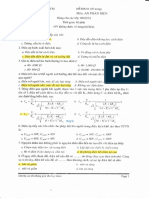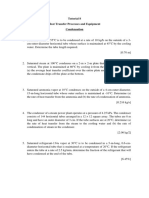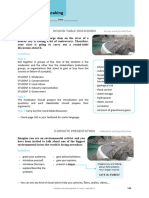Tutorial 6
Uploaded by
Hoài ThươngTutorial 6
Uploaded by
Hoài ThươngTutorial 6
Heat Transfer Processes and Equipment
Design of Shell and Tube Heat Exchanger
The Log Mean Temperature Difference Method
1. Steam in the condenser of a steam power plant is to be condensed at a temperature of
50°C (hfg = 2305 kJ/kg) with cooling water (Cp = 4180 J/kg.°C) from a nearby lake,
which enters the tubes of the condenser at 18°C and leaves at 27°C. The surface area of
the tubes is 58 m2, and the overall heat transfer coefficient is 2400 W/m2·°C. Determine
the mass flow rate of the cooling water needed and the rate of condensation of the steam
in the condenser.
[101 kg/s, 1.65 kg/s]
2. A double-pipe parallel-flow heat exchanger is to heat water (Cp = 4180 J/kg · °C) from
25°C to 60°C at a rate of 0.2 kg/s. The heating is to be accomplished by geothermal
water (Cp = 4310 J/kg · °C) available at 140°C at a mass flow rate of 0.3 kg/s. The inner
tube is thin-walled and has a diameter of 0.8 cm. If the overall heat transfer coefficient
of the heat exchanger is 550 W/m2·°C, determine the length of the heat exchanger
required to achieve the desired heating.
[25.5 m]
3. A 1-shell-pass and 8-tube-passes heat exchanger is used to heat glycerin (Cp = 2.5
kJ/kg.°C) from 27°C to 60°C by hot water (Cp = 4.18 kJ/kg.°C) that enters the thin
walled 1.3 cm diameter tubes at 80°C and leaves at 50°C. The total length of the tubes
in the heat exchanger is 120 m. The convection heat transfer coefficient is 23 W/m.°C
on the glycerin (shell) side and 280 W/m.°C on the water (tube) side. Determine the
rate of heat transfer in the heat exchanger (a) before any fouling occurs and (b) after
fouling with a fouling factor of 0.00035 m.°C/W occurs on the outer surfaces of the
tubes.
[8945 W, 8880 W]
4. A thin-walled double-pipe counter-flow heat exchanger is to be used to cool oil (Cp =
2200 J/kg·°C) from 150°C to 50°C at a rate of 2.5 kg/s by water (Cp = 4180 J/kg·°C)
that enters at 22°C at a rate of 1.5 kg/s. The diameter of the tube is 2.5 cm, and its length
is 6 m. Determine the overall heat transfer coefficient of this heat exchanger.
[34.6 kW/m2.°C]
Effectiveness–NTU Method
5. Hot oil (Cp = 2200 J/kg·°C) is to be cooled by water (Cp = 4180 J/kg·°C) in a 2-shell-
pass and 12-tube-pass heat exchanger. The tubes are thin-walled and are made of copper
with a diameter of 1.8 cm. The length of each tube pass in the heat exchanger is 3 m,
and the overall heat transfer coefficient is 340 W/m2·°C. Water flows through the tubes
at a total rate of 0.1 kg/s, and the oil through the shell at a rate of 0.2 kg/s. The water
and the oil enter at temperatures 18°C and 160°C, respectively. Determine the rate of
heat transfer in the heat exchanger and the outlet temperatures of the water and the oil.
[36.2 kW, 104.6°C, 77.7°C]
6. A cross-flow air-to-water heat exchanger with an effectiveness of 0.65 is used to heat
water (Cp = 4180 J/kg·°C) with hot air (Cp = 1010 J/kg·°C). Water enters the heat
exchanger at 20°C at a rate of 4 kg/s, while air enters at 100°C at a rate of 9 kg/s. If the
overall heat transfer coefficient based on the water side is 260 W/m2·°C, determine the
heat transfer surface area of the heat exchanger on the water side. Assume both fluids
are unmixed.
7. Glycerin (Cp = 2400 J/kg·°C) at 20°C and 0.5 kg/s is to be heated by ethylene glycol
(Cp = 2500 J/kg·°C) at 60°C and the same mass flow rate in a thin-walled double pipe
parallel-flow heat exchanger. If the overall heat transfer coefficient is 380 W/m2·°C and
the heat transfer surface area is 6.5 m2, determine (a) the rate of heat transfer and (b)
the outlet temperatures of the glycerin and the glycol.
[24 kW, 39.2°C, 40°C]
8. Steam is to be condensed on the shell side of a 1-shell-pass and 8-tube-passes
condenser, with 50 tubes in each pass, at 30°C (hfg = 2431 kJ/kg). Cooling water (Cp =
4180 J/kg·°C) enters the tubes at 18°C at a rate of 1800 kg/h. The tubes are thin-walled,
and have a diameter of 1.5 cm and length of 2 m per pass. If the overall heat transfer
coefficient is 3000 W/m2·°C, determine (a) the rate of heat transfer and (b) the rate of
condensation of steam.
[30.65 kW, 0.0126 kg/s]
You might also like
- Automatic Color Generation Using AVR MicrocontrollerNo ratings yetAutomatic Color Generation Using AVR Microcontroller4 pages
- PIC16F877A and LM35 Based Temperature Monitor - Eproject100% (2)PIC16F877A and LM35 Based Temperature Monitor - Eproject7 pages
- 127.0.0.1 Downloaded 73496.pdf at Thu Jul 12 13:03:22 ICT 2012No ratings yet127.0.0.1 Downloaded 73496.pdf at Thu Jul 12 13:03:22 ICT 2012258 pages
- 56 - A Learning Model For 8051 Microcontroller Case Study On Closed Loop DC Motor Speed Control PDFNo ratings yet56 - A Learning Model For 8051 Microcontroller Case Study On Closed Loop DC Motor Speed Control PDF7 pages
- Van Hanh TB Lo Hoi & Tuabin Cua NM Nhiet DienNo ratings yetVan Hanh TB Lo Hoi & Tuabin Cua NM Nhiet Dien440 pages
- Kinetics of The Partial Oxidation of MethanolNo ratings yetKinetics of The Partial Oxidation of Methanol16 pages
- Phụ Lục Bảng 1. Bảng Giá Trị Hàm LaplaceNo ratings yetPhụ Lục Bảng 1. Bảng Giá Trị Hàm Laplace2 pages
- Robotics - Bài 4 Kinematics - Velocity - Jacobian MatrixNo ratings yetRobotics - Bài 4 Kinematics - Velocity - Jacobian Matrix26 pages
- Lab 03: C Programming in Linux by Using GCC: A. Learning OutcomeNo ratings yetLab 03: C Programming in Linux by Using GCC: A. Learning Outcome3 pages
- Bộ Lọc Kalman Rời Rạc - Môn Xử Lý Tín Hiệu SốNo ratings yetBộ Lọc Kalman Rời Rạc - Môn Xử Lý Tín Hiệu Số4 pages
- Example - Basic Neutralizer Control SystemNo ratings yetExample - Basic Neutralizer Control System3 pages
- Ky Thuat Dieu Khien Tu Dong - Control System Technology-Lab Tutorials PDFNo ratings yetKy Thuat Dieu Khien Tu Dong - Control System Technology-Lab Tutorials PDF44 pages
- (BS 1041-5-1989) - Temperature Measurement. Guide To Selection and Use of Radiation Pyrometers PDFNo ratings yet(BS 1041-5-1989) - Temperature Measurement. Guide To Selection and Use of Radiation Pyrometers PDF42 pages
- Properties of Refrigerant 22 (Chlorodifluoromethane)100% (1)Properties of Refrigerant 22 (Chlorodifluoromethane)66 pages
- Tutorial 8 Heat Transfer Processes and Equipment CondensationNo ratings yetTutorial 8 Heat Transfer Processes and Equipment Condensation2 pages
- Tbi11p01 Mep CA 009 Calculation For Hvac Ra IfrNo ratings yetTbi11p01 Mep CA 009 Calculation For Hvac Ra Ifr10 pages
- Eberspacher Espar Airtronic d2 Operating Instruction ManualNo ratings yetEberspacher Espar Airtronic d2 Operating Instruction Manual32 pages
- Standard - Speaking - U2.1-2.2 - Round-Table Discussion - 5-Minute PresentationNo ratings yetStandard - Speaking - U2.1-2.2 - Round-Table Discussion - 5-Minute Presentation2 pages
- Kiln Operations Guide Lines: PB:Ghassan AL-AbbadiNo ratings yetKiln Operations Guide Lines: PB:Ghassan AL-Abbadi43 pages
- Collision Avoidance Using Pneumatic Bumper PPT 2No ratings yetCollision Avoidance Using Pneumatic Bumper PPT 234 pages
- SMETA 4 Pillar - Doc 2 Environmental and Business Practice Sections Only.No ratings yetSMETA 4 Pillar - Doc 2 Environmental and Business Practice Sections Only.3 pages
- Internal Versus External Shading Devices Performance in Office BuildingsNo ratings yetInternal Versus External Shading Devices Performance in Office Buildings10 pages
- Class 6 Adarsha Vidyalaya Entrance Exam Questions PDF Download100% (1)Class 6 Adarsha Vidyalaya Entrance Exam Questions PDF Download27 pages
- 380 395w 72 Cell Monocrystalline Silver WhiteNo ratings yet380 395w 72 Cell Monocrystalline Silver White2 pages
- Performance Deterioration in Industrial Gas TurbinesNo ratings yetPerformance Deterioration in Industrial Gas Turbines8 pages
- Reliability of HV/MV Substations With Air-Isolated and Gas-Insulated SwitchgearNo ratings yetReliability of HV/MV Substations With Air-Isolated and Gas-Insulated Switchgear9 pages
- Analysis of Pressure Increase During Filling of Pressurized LPG Storage SystemsNo ratings yetAnalysis of Pressure Increase During Filling of Pressurized LPG Storage Systems4 pages































































































